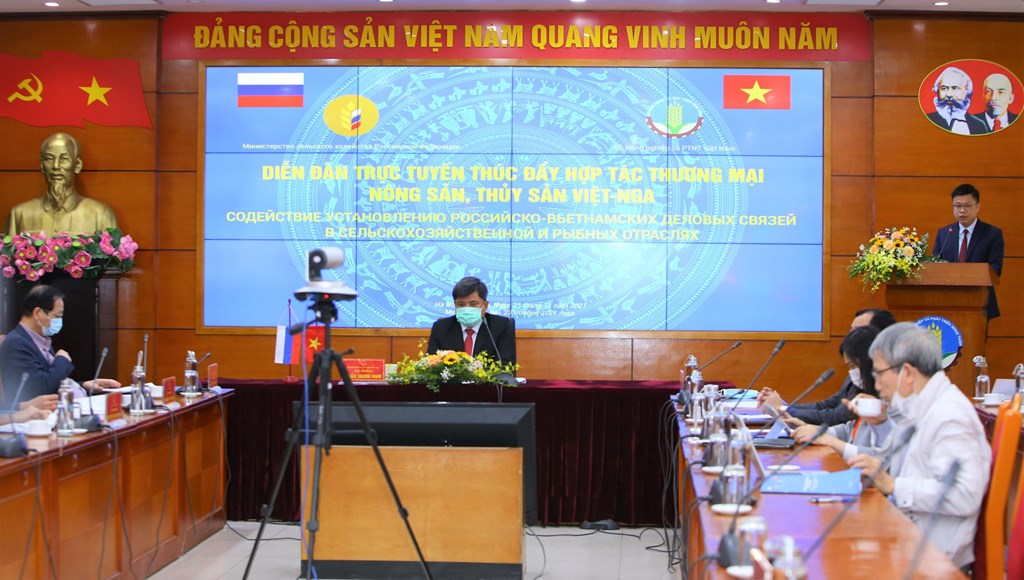AEAU opens up huge opportunities for Vietnam-Russia economic cooperation
The combined market size of 250 million people is a significant incentive for companies from the two countries to tap into the potential, contributing to reaching the bilateral trade revenue goal of $10 billion.
The Free Trade Agreement between Vietnam and Eurasian Economic Union or AEAU (including Russia, Armenia, Belarus, Kazakhstan, and Kyrgyzstan) has opened up huge opportunities for Vietnam and Russia's economic cooperation, especially in farm and seafood trading.
| Overview of the conference. Photo: VNA |
Russian Deputy Minister of Agriculture Sergey Lvovich Levin gave the remarks during a virtual conference discussing Vietnam-Russia prospects in agricultural and fishery trade cooperation held today [November 23].
According to Levin, Vietnam is one of the most dynamic and advanced markets in the region. The Covid-19 pandemic could not prevent strong growth in farm trade turnover, for which Levin expected the two nations to further push bilateral cooperation in this field to a new height in the post-pandemic period.
Sharing the Russian official’s view, Vice Minister of Agriculture and Rural Development Tran Thanh Nam said Vietnam is Russia’s largest trading partner in Southeast Asia and sixth in the Asia-Pacific.
Bilateral trade turnover during the 2018-2020 period averaged US$4.5 billion, in which agricultural revenue made up 18-20% or $900 million per year.
For the first 10 months of 2021, Vietnam’s exports of agro-forestry-fishery to Russia surged by 32.6% year-on-year to $469 million, mainly seafood, coffee, fruits, rice, tea. In return, Vietnam imported wheat, fertilizer, wood, meat, and dairy products from Russia.
“Both sides need to take drastic actions to grasp opportunities during the pandemic and push for greater cooperation in agricultural trade,” Nam said.
Vietnam’s Trade Counsellor in Russia Duong Hoang Minh added thanks to the AEAU, where the majority of Vietnam’s farm produce and seafood to Russia are subject to 0% import tariff, giving its products a greater advantage compared to those from other countries that do not have a similar trade agreement with Russia.
“More importantly, Vietnam has a large number of enterprises that have been active in the Russian market for a long period,” Minh said.
To further boost trade relations with Russia, Minh called for local firms to actively take part in major trade fairs held in Russia to better understand market preferences.
“A deep insight of the Russia market is essential, and should be the priority for Vietnamese companies in the coming time,” Minh added.
Minh also suggested local firms focus on processed food or products of higher added value, including coffee, seafood, fruits, instead of exporting raw products with a low value to the Russian market.
The need for both sides to work on differences
Vice President of the Vietnam Association of Seafood Exporters and Producers (VASEP) To Tuong Lan stressed that Russia remains a potential market for Vietnam’s seafood.
“The EAEU is providing local firms with an ideal platform to penetrate the market, but the Russian authorities have strict requirements on food safety and quality control,” Lan said.
Lan also pointed out the complicated procedures for firms to get export licenses to the Russian market that are making it difficult for many companies to penetrate the market.
Meanwhile, firms subjected to export limitation to Russia face a long-drawn process to address concern from Russian authorities, Lan said, referring to the unresolved case of 10 out of 22 local catfish export companies whose sales to Russia have been suspended since 2014.
“Both sides should enhance cooperation and work out differences in the trade process to take farm trade relations to a new level,” she said.
In this regard, Vice Minister Nam expected the upcoming visit of Vietnam’s State President Nguyen Xuan Phuc to Russia would be an opportunity for both countries to strengthen economic relations.
Nam stressed given the combined population of 250 million, the market size is a significant incentive for companies from both countries to tap into the potential, in turn contributing to reaching the bilateral trade revenue goal of $10 billion.











